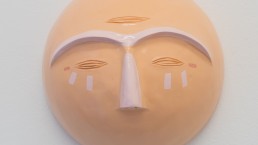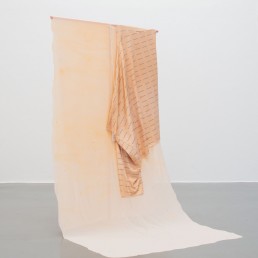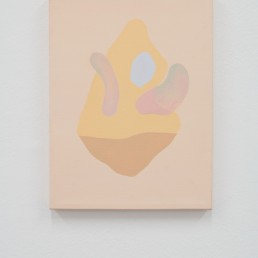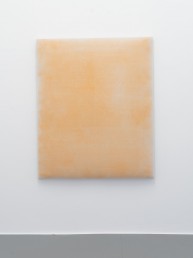"I don't want to foresee an apocalyptic future as we are sometimes accustomed to thinking of, but I want to see it as a possibility for the birth of a new era."
Gioia di Girolamo’s solo show “The Mating Season of Frenzy Breeze” runs through June 14th 2019 at Bianconi Gallery.
The Italian-born, LA-based artist’s exhibition, curated by Andrea Lacarpia, explores how social interactions have been irreversibly altered by digitalisation. Di Girolamo tells this story by investigating the mechanisms behind human relationships and the development of organisms.
The questions she raises are all-too-familiar and at times difficult to face. Which new neuroses and addictions have developed through our contemporary screen-based, immediate modes of communication? How can we be both in constant contact with the world around us, and at the same time so deeply isolated?
Through her often amorphic artworks, Di Girolamo suggests that people are losing touch with their own human physicality. Her fictional character Frenzy Breeze explores this notion, acting as a metaphor for our contemporary world. Here, physical presence is replaced by online images and narratives. These surrogates offer temporary sensory satisfaction, replacing real experience in a shadow game resembling a modern-day version of Plato’s cave.
We had the chance to meet Gioia di Girolamo and discuss the topics she raises with her art.



The topic you raise with your exhibition “The Mating Season of Frenzy Breeze” is very delicate, and I’m sure most visitors would identify with your artworks. Would you expand further on your vision related to affectivity in social relationships and how digitalisation is impacting it?
Gioia di Girolamo: Absolutely, yes. At the moment it is a subject that particularly interests me and that I am investigating. I would like to touch aspects that I have not analysed yet, go deeper into the two tracks of my research and summarise them. I like to think of my work as having a double lane, a more material one linked to a stronger ancestral aspect of human identity and a more contemporary and futuristic aspect, expressed mainly through the technological and digital part.
The environment surrounding your artworks is carefully designed, so much so that it becomes a part of them, and guides the visitors through the artistic experience. What kind of materials did you use and what kind of associations did you want to evoke?
Gioia di Girolamo: I like to use different materials. The choice changes depending on the work and which aspect I am going to analyse. Consequently, I continue to research and experiment and I am always curious to use new materials if I find it relevant to what I do. I currently use many different types: fabric, spray or brush colours, canvases, synthetic clay, enamels, gloves, soap, plastic, cables, tablet, videos. The sound is a fundamental part of the work as well. I am interested in creating a completely immersive dimension whenever I have the chance, which happened at the Bianconi Gallery, and being able to give a completely alienating and sensorial experience to fully immerse yourself in.

You moved from Italy to Los Angeles and I am curious if, and to what extent, this move affected you as an artist.
Gioia di Girolamo: Moving to the US was a huge change in my life and my work was inevitably influenced by it. I used to live in Pescara and Milan, and then moving to LA was definitively an emotional storm. In such a big city and with hectic work times, the approach to human relationships is completely different. Moreover, the city of Los Angeles is full of greenery, parks, gardens and animals. This is a beautiful feeling, but it is also true that in some way these green spaces are often artificial. Being such a vast and densely populated metropolis, a large part of the green areas are man-made. I realised that I was spending a lot of time between outdoor walks in artificial green space and conversations almost exclusively via chat, Skype or email. All the concepts I have worked on were enhanced by personal experiences.
"I realised that I was spending a lot of time between outdoor walks in artificial green space and conversations almost exclusively via chat, Skype or email."
Do you plan to continue to research this topic and what do you think the scenario will be in the near future concerning how our affectivity will evolve? Are we going to be empowered, anaesthetised or rewired?
Gioia di Girolamo: Sure. My research is constantly evolving and I do not set barriers. My work stays up to date with our society, and we change based on its evolution. I’m sure there will also be new topics that I will be interested in investigating over time. I don’t know what will happen but I prefer to face things with a positive spirit. I hope there will be an awakening.
The introduction of technology into our lives is an inevitable fact and a sign of human evolution. There are many ways of living this change and many ways in which we are currently fighting for a reawakening of conscience and attention towards the environment. I am sure that even in this respect, with time, we will learn more and more about using technology constructively and to our advantage, in an increasingly intelligent and evolved manner, also in human relationships. I don’t want to foresee an apocalyptic future as we are sometimes accustomed to thinking of, but I want to see it as a possibility for the birth of a new era.
In your opinion, what kind of mark has digitalisation left on the art world (and the art industry) itself? How has it changed the relationship between the artist and the audience by making art more accessible and democratic?
Gioia di Girolamo: It has definitely left a big mark, upending the way people enjoy art, its diffusion and consequently also the market. Like all changes, this involves a period of adjustment. We have all been able to see how digitalisation has given birth to new realities.
The Ultrastudio artist run space, of which I am a co-founder, is an example of this opportunity. At the same time, those who have been working in the art industry for a long time and who have already learned, or are learning, to evolve their old approaches to meet the market needs, will not lose their position but consolidate it. Let’s say it is a sort of natural selection. As far as the artist and the public are concerned, I believe that having the possibility to express and to be seen is a healthy right which no one should be denied. It opens up possibilities for noticing new talents from anywhere in the world and giving them credit more easily.

Gallery
Galleria Bianconi
Opening year
2004
Opening Times
Mon – Fri
10.30 – 13
& 14.30 – 18
Sat: by appointment
+39 02 2222 8336
Address
Via Lecco 20
20124 Milan
Italy